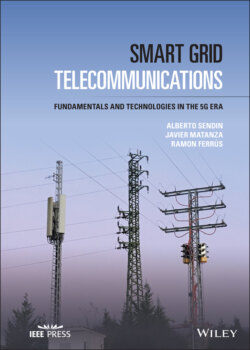Читать книгу Smart Grid Telecommunications - Ramon Ferrús - Страница 18
1.2.2 The Grid
ОглавлениеThe “grid,” the power grid, the electric power system, or the electricity supply system, is defined by the IEC as “all installations and plant provided for the purpose of generating, transmitting and distributing electricity.”
The power grid is a hierarchical infrastructure comprising a large set of interconnected elements to provide electricity service to its end‐customers. The interconnected elements can be grouped in different building blocks, as shown in Figure 1.2. Traditional grids deliver the energy produced by the Generation systems to the Consumption Points, through Transmission and Distribution systems. Generation and consumption are matched in real time.
In a traditional conception of the power system, Generation is conceived as the big power plants where energy transformation into electricity happens. Transmission steps generated voltage levels up, to transport it over long distances with the minimum energy losses. Distribution drives electric energy to all the disperse locations where it is consumed. Finally, Consumption Points are the locations where energy is ultimately delivered.
In practical and intuitive terms, Generation is the block with the big thermal, nuclear, and hydro plants. Transmission grid transports electricity with the costly HV power lines acting as the highways of the energy. Distribution grid is the heterogeneous mix of pervasive electricity assets reaching everywhere (the assets in Transmission and Distribution can be simplified in two, substations and power lines). And Consumption Points conceptually gather the different electricity users and their loads, from commercial and industrial customers to residential ones. Last but not least, Distributed Generation (DG) and/or DER have started to play a relevant role in the power generation closer to end‐customers.
Figure 1.2 Building blocks of traditional electric power systems.
Thus, the power grid is usually understood as a very large network connecting power plants (large or small) to loads, by means of an electric grid that spans countries, with international interconnections. These are referred to as “full power systems,” autonomous in their operation.
